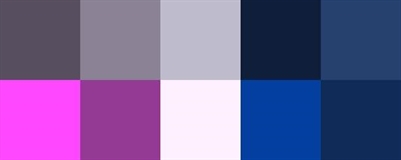- Modules
- Colour Styling
- Activity 2: Creating a Five-Colour Palette
Activity 2: Creating a Five-Colour Palette
T-DES-003-022
The following exercise will be divided in three parts for the basic project, and two extra assignments if you feel ready to push this further. The goal is to allow you to create a thought process when creating a colour palette. Don’t hesitate to question your intentions at every step. Feel free to also read all the previous information a second time if at any step the exercise it feels overwhelming.
Material
- MO-DES-003/03-lake-background-lines.tpl
- MO-DES-003/04-lake-background-colours.tpl
Keywords
First, take the time to write down a list of keywords that inspire you colours or colour palettes. You will write down ten. Here are a few examples of what it could be: Spring morning, dark alley, anger or sickness. Keep it short and try to quickly capture in your mind an image of what that could be.
Building Palettes
For the second part of this project, you will need to pick your top three keywords. Pick the ones that inspire you best! From there, you will create three individual colour palettes based on those very keywords. Each palette you create must have five colours.
Here is an example of what one of those palettes could be:

We chose the keywords: Warm Autumn.
Using Palettes
This is where the real work begins! Using the following illustration, you will do three illustrations. Each one will use one of your custom palettes.

Remember that you are trying to create a different mood in each version. Make sure that colours are not all over the place. You need to understand that you are at a lake with a sky, trees, a deck and water. Also, you cannot add any extra colours to your palette. Stick to your five colours.
Here's an example of how the palette can be used to colour the illustration:

It is interesting to note that we also coloured the lines and set them to Multiply, instead of keeping them black. We picked colours from our palettes using some of the lightest colours for the ripples.
What do you take away from this exercise?
Applying the System (Optional)
Repeat the previous exercise using your own illustration. Think carefully about what you want to illustrate and what kind of mood you want to create with it. Search for references that will help you create your artwork and build a simple colour palette before starting any colouring.
For this exercise, build a ten-swatch palette. It will give you a bigger range.

Our keywords for this palette was Dark Alley. We imagined a dangerous city alley at night lit by a single hot pink neon light.
Once you have completed your work, ask yourself:
- What do you prefer? A simple five-swatch palette or ten swatches?
- Are there advantages or disadvantages with each options?
- Is having more colours always better? Why?
Make sure to list them, then share your thoughts with other students. Knowing your preferences and how building a palette that fits your techniques will make the task of colouring less daunting.
Time Estimated 30 mins
Difficulty Level Beginner
Topics List
- Introduction to Colour Styling
- Design Organization
- Basic Colour Theory
- Colour Anatomy
- Standard Colour Wheel
- Yurmby Colour Wheel
- Colour Schemes
- Monochromatic Colour Scheme
- Complementary Colour Scheme
- Analogous Colour Scheme
- Triadic Colour Scheme
- Split Complementary Colour Scheme
- Tetradic Colour Scheme
- Warm and Cool Colour Scheme
- How Our Brain Understands Colours
- Building a Simple Palette
- Preparing Your Research
- Adding to a Colour Scheme
- Thumbnailing
- Gamut Mapping
- Activity 1: Creating a Colour Palette
- Activity 2: Creating a Five-Colour Palette
- Activity 3: Painting a Colour Model